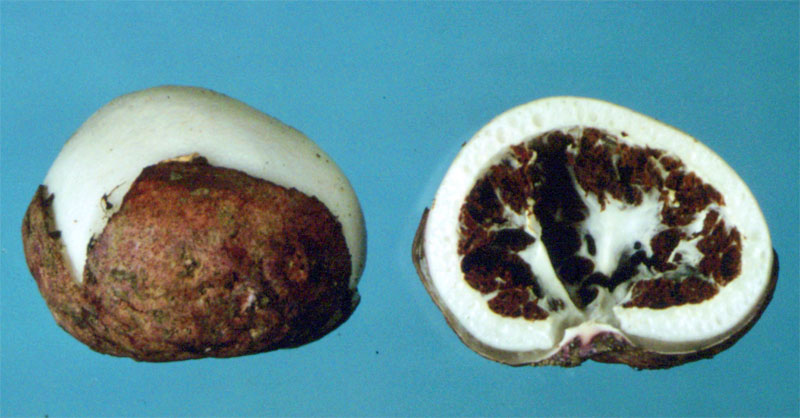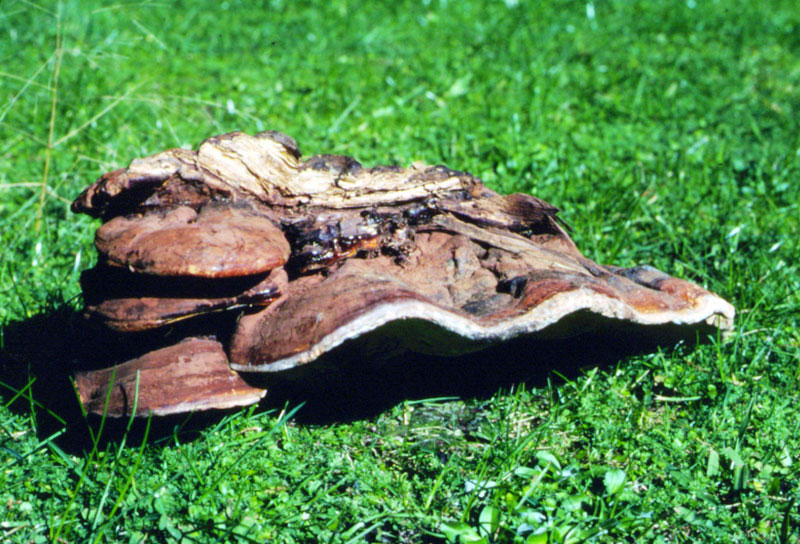[Picture: Hypocreopsis amplectans, tea tree fingers – IUCN Red List status as Critically Endangered. Known from only 2 locations in ANZ but not seen for several years. (photo: (c) Reiner Richter, CC BY-NC-SA; scale: fruitbody typically 2-4 (-6.5) cm across)]
During Conservation Week, it’s appropriate to be reminded of Aotearoa New Zealand’s (ANZ’s) unique fauna and flora, and the efforts undertaken by government, iwi, farmers, and community agencies to conserve our special taonga.
But how about conservation of our Funga? As a term, funga is the fungal equivalent of fauna for animals, and flora for plants. At last, we have a word gaining in popularity to cover regional members of Kingdom Fungi – with its explanation well expounded by Kuhar et al. (2019).
ANZ’s funga might be less obvious than fauna and flora to most people, while being essential to processes supporting healthy ecosystems. For example, our funga help roots of almost all plants in ANZ to absorb water and minerals from soils, and are the prime agents of decomposition and nutrient cycling. While their impacts are profound, their visibility tends to be low apart from the larger (macro-) fungi such as the mushrooms during autumn.

ANZ’s funga, like our fauna and flora, include many threatened species that deserve our conservation awareness and action. Several of these fungi have recently been accorded international IUCN Red List status – see the Forest & Bird article by Wood (2019). Conservation is also needed at the habitat level.
Old growth forests such as those comprising much of our national parks are valued for multiple reasons. In addition to their sanctuary status for fauna and flora, such forests are invaluable for conservation of fungi, many species of which are confined to growth on and within ancient trees. Their recognition adds significantly to the conservation value of these habitats.
Our knowledge of ANZ’s funga is far from comprehensive, with only about 30% of our expected funga (by international comparison) recorded to date. Nevertheless, in a preliminary assessment of threat status of our macro-fungi, two species are recognised by the IUCN Red List at the highest threat status of Critically Endangered: Hypocreopsis amplectens and Deconica baylisiana.
Of the 45 ANZ fungal species assessed by IUCN Red List, nine are considered to be Endangered (including Boletopsis nothofagi, Claustula fischeri, and Ganoderma sp. “Awaroa”), two are ranked Vulnerable, and the remaining 32 are in lower threat categories.

Threatened ANZ funga are a focus for a number of keen amateurs and professionals, and records of target species are welcome via iNaturalist where the emphasis is on observation, accurate recording of location and habitat, and quality photographs – but not removal!
Manaaki Whenua – Landcare Research (MWLR) is the national centre for research and information on ANZ’s funga, and hosts the national collections of dried fungal specimens (Fungarium PDD with over 100,000 specimens) and of living cultures (Culture Collection ICMP with over 10,000 cultures), along with an exhaustive database about ANZ’s funga (NZFUNGI). MWLR staff are also represented on the Australasian Fungi Conservation Group where new members are welcome.
Also welcome are your questions and your interest as fellow conservationists to embrace our FUNGA in addition to fauna and flora.
References
Wood C 2019. Secret Life of Fungi. Forest & Bird 373: 20-22 [+ cover]
“Peter is a fungal scientist (mycologist) with Manaaki Whenua – Landcare Research in Auckland. His main role is as science team leader for colleagues who research systematics of fungi, bacteria, plants, and invertebrates; the team also manages five national collections of these biota, including the NZ Fungarium of dried fungal specimens and ICMP culture collection of living fungal strains.
His research on fungi addresses taxonomy and applied uses of wood decay species, and fungal conservation. He is also keen to promote awareness and education about fungi, co-establishing the annual NZ Fungal Forays in 1986 and, for more general biodiversity awareness, urban BioBlitz from 2004.
In addition to assisting DOC with advice on threatened fungi, Peter is active with the Global Fungal Red List Initiative to assemble data on NZ’s threatened fungi for IUCN Red Listing. By late 2019, 30 NZ species were accepted by IUCN for Red Listing, among 285 fungal species globally (cf. 40,000 plants and 75,000 animals). He is a member of the IUCN SSC Fungi Specialist Group.”

